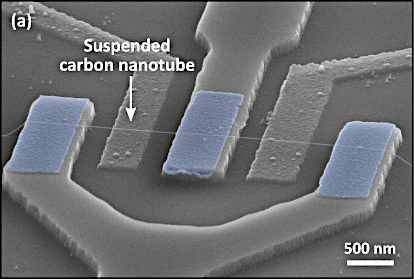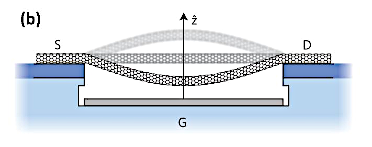Interfacing double quantum dot physics and nano-mechanics in a single carbon nanotube
-
Job Type:
Master
- Contact Person:
Context: The last two decades have seen fast progress in the research field of nano-mechanical resonator [1], enabling to use these systems to study quantum mechanic at the scale of a single quanta. The recent advances in this field such as nonclassical mechanical states generation or entanglement between distinct resonator, offer great promise in the context of quantum computing such as the storage of quantum information, the realization of mechanical qubits or even coupling separated qubits using phonons.
Among the various physical implementations of nano-mechanical resonators, carbon nanotubes are very attractive candidates. Thanks to their small dimensions (diameter of 1-4nm) they possess very high resonance frequency (from 50MHz to few GHz), very large quality factor (up to few millions) [2], and large zero-point motion fluctuations (few pm). Besides, one can easily perform quantum transport experiments in carbon nano- tubes via the confinement of a single electron. The interplay between the dynamics of an electron in a quantum dot and the mechanical degree of freedom of a carbon nanotube give rise to a wealthy physics. Nevertheless, bridging the domain of nano-mechanics and quantum transport remains a challenge. To make the fabrication of such hybrid circuits possible, we developed a home-made nano-assembly technique [3] which allows us to integrate the carbon nanotube inside an almost-arbitrary complex nano-circuit.


Fig. 1: (a) SQUID-circuit built out of a suspended carbon nanotube using our home-made nano-assembly technique. (b) Schematic of a vibrating carbon nano- tube with a built-in single quantum dot. Taken from [2]
Project: The project will focus on the realization of a double quantum dot inside a suspended carbon nanotube. The fabrication of the circuit would be partially done by the master student including cleanroom fabrication (design and fabrication process are both already developed). The Master student will then perform the meas- urement of the hybrid-circuit thanks to our cryogenic setup. These measurements include low-frequency transport measurement (DC and lock-in measurements) as well as RF measurements of the nanomechanical resonator.
Reference:
[1] Mesoscopic physics of nanomechanical systems
A. Bachtold, J. Moser, and M. I. Dykman Review of Modern Physics 94, 045005 (2022)
[2] Nanotube mechanical resonators with quality factors of up to 5 million
J. Moser et. al, Nature Nanotechnology 9, 1007 (2014)
[3] Nanoassembly technique of carbon nanoubes for hybrid circuit-QED
T.Cubaynes, et. al, Appl. Phys. Lett 117, 114001 (2020)
PDF version of the advertisement (ca. 284 kB) available here.

